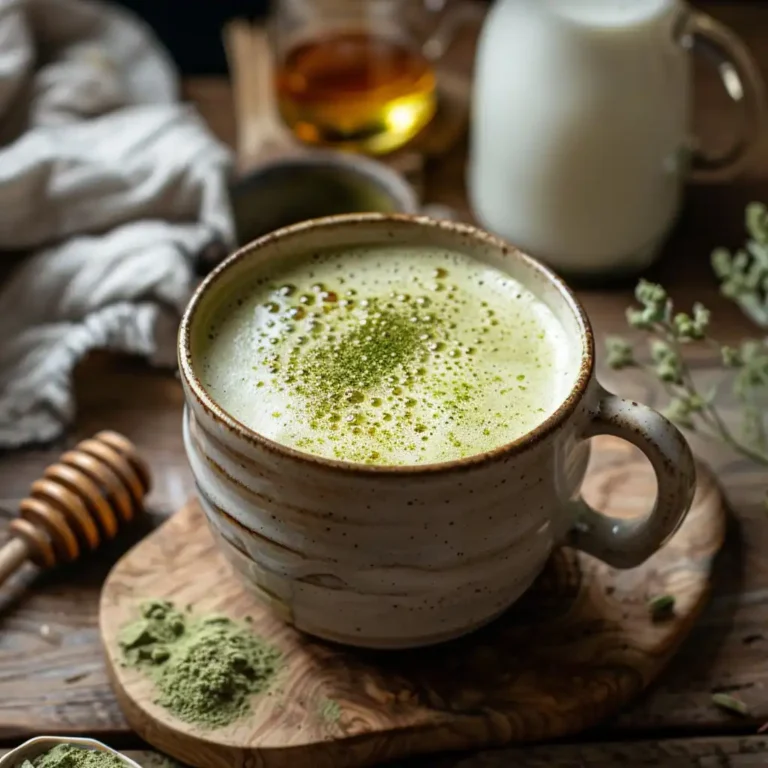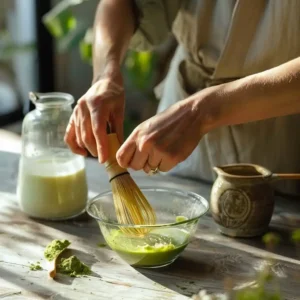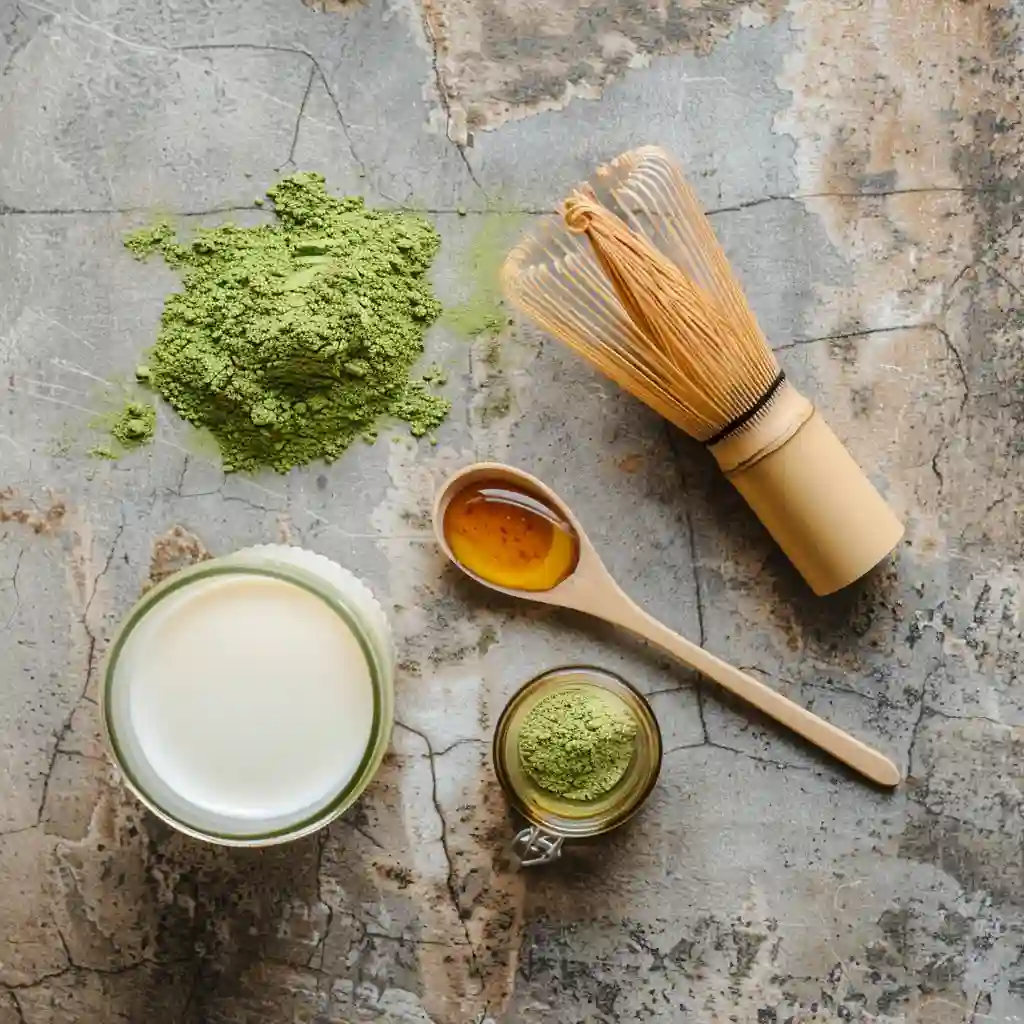Starbucks Matcha Green Tea Latte Nutrition isn’t just a search term—it’s a question I asked myself the first time I ordered one on a chilly spring morning in Portland. I’d just returned from a trip to Japan where matcha was served pure and earthy, without the creamy sweetness I’d tasted in the Starbucks version. That flavor difference got me curious, and eventually, concerned: how healthy is this matcha latte, really?
In this guide, I’ll walk you through every detail behind Starbucks Matcha Green Tea Latte Nutrition—from calorie count and sugar levels to whether the drink is sweetened or not. You’ll also learn how to make smarter swaps and what healthier alternatives can look like, whether you’re sipping on the go or recreating the flavor at home.
Because I’ve spent years in my own kitchen experimenting with matcha—from smoothies to beauty blends—you’ll get my personal insights too. And if you’ve ever wondered, “Is this drink helping or hurting my health goals?”—you’re definitely not alone.
Starbucks Matcha Green Tea Latte Nutrition has become a talking point for anyone trying to make more mindful choices. Understanding what goes into that bright green cup is the first step to taking control of your daily routine.
Check out this related post to start your green tea journey with more control: Discover great ideas like this matcha collagen beauty smoothie.
Let’s dig into the full nutritional profile—what’s really in that cup?
Table of Contents
Understanding Starbucks Matcha Green Tea Latte Nutrition
What’s in a Starbucks Matcha Green Tea Latte?
Starbucks Matcha Green Tea Latte Nutrition starts with understanding what actually goes into the drink. It may sound like a simple blend of green tea and milk, but there’s more under the lid. The core ingredients include:
- Matcha powder (which is actually a mix of sugar and ground Japanese green tea)
- 2% milk (unless you customize it)
- Hot water or ice, depending on how you order
Here’s the kicker: Starbucks doesn’t use pure matcha. Their signature powder is roughly 50% sugar and 50% finely ground green tea. That means, even before the milk gets involved, you’re sipping on something already quite sweet.
For a Grande (16 oz) hot latte, here’s the average nutritional breakdown:
- Calories: ~240
- Sugar: ~32g
- Fat: ~7g
- Protein: ~8g
- Carbohydrates: ~34g
Nutritional Breakdown: Calories, Sugar, Carbs, and Fat
Let’s take a closer look at how Starbucks Matcha Green Tea Latte Nutrition stacks up against your daily intake goals.
| Nutrient | Amount (Grande) |
|---|---|
| Calories | 240 kcal |
| Total Sugar | 32g |
| Fat | 7g |
| Protein | 8g |
| Carbohydrates | 34g |
When you compare it to plain green tea, the Starbucks Matcha Green Tea Latte Nutrition profile clearly shows higher calories and sugar—mainly from the sweetened powder and milk. That said, it does offer some protein and antioxidants from the matcha. Like anything indulgent, it’s all about balance.
Don’t miss our anti-inflammatory smoothies for healthier, sugar-conscious sipping!
Print
Starbucks Matcha Green Tea Latte Nutrition: The Truth About Calories, Sugar, and Health Benefits
Curious about what’s really in your Starbucks Matcha Green Tea Latte? This breakdown covers everything from sugar content to portion sizes, helping you sip smarter.
- Total Time: 5 minutes
- Yield: 1 drink 1x
Ingredients
- Starbucks matcha powder (50% sugar, 50% green tea)
- 2% milk (standard)
- Hot water (for hot version)
- Ice (for iced version)
- Optional: alternative milks like almond or coconut
- Optional: fewer scoops of matcha to reduce sugar
Instructions
- Order a Tall, Grande, or Venti based on your preference for size and sugar content.
- Customize with fewer scoops of matcha powder to reduce sugar (1 scoop = ~7.5g sugar).
- Choose a lower-calorie milk option such as unsweetened almond or coconut milk.
- Request no syrup to avoid extra added sugars.
- Optionally, recreate the drink at home using ceremonial-grade matcha, hot water, unsweetened milk, and a touch of natural sweetener.
- For a homemade version: Whisk 1 tsp matcha with 1/4 cup hot water. Add 3/4 cup unsweetened milk. Sweeten optionally. Enjoy hot or iced.

Notes
The Starbucks version contains about 32g sugar per Grande size. For a healthier option, reduce matcha scoops or make it at home. Be mindful of milk and syrup choices to lower calorie and sugar intake.
- Prep Time: 2 minutes
- Cook Time: 3 minutes
- Category: Boisson
- Method: Infusé / Mélangé
- Cuisine: Américaine / Fusion
Nutrition
- Serving Size: 1 Grande (16 oz)
- Calories: 240
- Sugar: 32g
- Sodium: 80mg
- Fat: 7g
- Saturated Fat: 4.5g
- Unsaturated Fat: 2g
- Trans Fat: 0g
- Carbohydrates: 34g
- Fiber: 0g
- Protein: 8g
- Cholesterol: 25mg
Is Starbucks Matcha Green Tea Latte Healthy?
Antioxidants and Wellness Associations of Matcha
I first discovered the magic of real matcha during a layover in Tokyo. The earthy, slightly bitter tea was whisked by hand and served without milk or sugar. That pure form is where matcha truly shines—it’s rich in catechins, especially EGCG (epigallocatechin gallate), a powerful antioxidant often linked to potential health benefits like supporting metabolism and reducing oxidative stress.
When you drink matcha in its unaltered form, you’re tapping into centuries of Japanese tea tradition. But when it comes to Starbucks Matcha Green Tea Latte Nutrition, it’s a different picture. Since the blend is sweetened by default, those natural benefits can get buried under all that added sugar.
That said, matcha still brings:
- A smoother caffeine lift compared to coffee
- Natural L-theanine, known to support relaxation and mental clarity
- Light detox potential through traditional use, especially when consumed without sugar
So, yes—matcha has some healthful traits. But the Starbucks Matcha Green Tea Latte Nutrition numbers reveal a much sweeter, more indulgent drink than the traditional tea ritual.
When a Latte Becomes a Sugar Trap: Health Perspectives
A common question I hear is, “Isn’t green tea healthy?” Definitely. But once you stir nearly four teaspoons of sugar into that cup, the story changes.
Based on current guidelines, women should limit added sugar to 25g per day, and men to 36g. One Grande Starbucks Matcha Latte? It clocks in at 32g of sugar—almost your entire daily allowance.
That doesn’t mean you have to cut it out completely. I’ve enjoyed plenty of them, especially when I needed something cozy on a long drive. But the key is understanding what Starbucks Matcha Green Tea Latte Nutrition really means—and using that knowledge to make better choices.
Downsize the drink. Choose unsweetened milk. Or make your own at home (we’ll get there in Part 7).
Looking for inspiration? Try our mounjaro drink for digestion—a naturally light and refreshing option.
Calories in Starbucks Matcha Latte – Why So High?
The Role of Milk Choice and Portion Size
When talking about Starbucks Matcha Green Tea Latte Nutrition, it’s easy to assume matcha powder is the calorie culprit. But the real hidden calorie load often comes from the milk. A standard Grande is made with 2% milk, adding creaminess—but also about 120 calories on its own.
And let’s not ignore portion size. The bigger the cup, the more scoops of sweetened powder and milk you get.
Here’s a quick breakdown:
| Size | Calories |
|---|---|
| Tall (12 oz) | 190 kcal |
| Grande (16 oz) | 240 kcal |
| Venti (20 oz) | 310 kcal |
As you can see, calories scale quickly with size. That creamy, cozy drink may feel satisfying, but it can push your daily intake faster than expected.
Syrups and Sweeteners: Where the Extra Calories Come From
One thing often overlooked in conversations about Starbucks Matcha Green Tea Latte Nutrition is how sweet the matcha powder actually is. Starbucks doesn’t use pure matcha. Instead, it’s a pre-mixed powder made of 50% sugar and 50% powdered green tea.
Here’s what that means for a Grande:
- 3 scoops = ~45g powder
- ~22.5g of that is sugar
Add in the sugar from milk, and your “tea” becomes more of a dessert.
This is why the latte, despite being based on a healthy-sounding ingredient, can end up feeling heavy. It’s still better than a whipped cream frappuccino—but it’s not the “clean” energy drink it’s sometimes marketed to be.
So if you’re mindful of your diet or sugar intake, tweaking your order is a smart move. Smaller size, fewer scoops, plant-based milk—you get control back.
Looking for something lighter? Don’t miss our color-changing mounjaro drinks—a naturally vibrant, calorie-smart option.
Starbucks Matcha Green Tea Latte Sugar Content
Hidden Sugars in the Starbucks Blend
I remember thinking my first Starbucks matcha tasted unusually sweet—and not in a subtle, honey-drizzled way. It turns out I wasn’t imagining it. Starbucks doesn’t use ceremonial-grade or even culinary matcha. Instead, they blend their drinks with a sweetened green tea powder, and that sweetness? It’s built right in.
One scoop contains about 7.5g of added sugar, and a Grande has 3 scoops. That adds up to 22.5g of sugar before milk even enters the picture. Depending on your milk choice, you could be sipping over 32g of sugar—a surprising stat in any breakdown of Starbucks Matcha Green Tea Latte Nutrition.
Here’s a quick sugar comparison:
| Drink | Sugar (g) |
|---|---|
| Grande Matcha Latte (2% Milk) | 32g |
| Grande Caramel Macchiato | 27g |
| Can of Coca-Cola (12 oz) | 39g |
For a drink that many assume is “just green tea,” this level of sugar is a wake-up call. While it may not taste like soda, the sugar content still plays a big role in overall Starbucks Matcha Green Tea Latte Nutrition.
How Matcha Lattes Compare to Other Starbucks Drinks
So how does the matcha latte measure up in the Starbucks lineup? Honestly, it’s among the highest in sugar, even though it’s often promoted as a lighter, tea-based choice.
Let’s take a look:
- Iced Matcha Latte (Grande): ~28g sugar
- Chai Tea Latte (Grande): ~42g sugar
- Cold Brew with Sweet Cream: ~14g sugar
Clearly, even with its plant-based image, the matcha latte belongs more in the dessert zone than in the wellness lane. That’s why understanding Starbucks Matcha Green Tea Latte Nutrition is so important—so you can choose whether to sip mindfully or switch it up.
Still craving that creamy, comforting feel? I get it. I’ve had my fair share during long writing days and afternoon slumps.
If you’re looking for a no-guilt sip, check out our lemon and olive oil in the morning recipe—it’s naturally energizing and refreshingly light.
Sweetened or Unsweetened? What You Need to Know
The Truth About Pre-Sweetened Matcha Powder
Let me tell you—when I first tried making a matcha latte at home, I grabbed a tin of ceremonial-grade matcha from a tiny Japanese grocery. It was grassy, slightly bitter, and deeply green—nothing like the mellow, almost dessert-like version from Starbucks. That was the moment I realized what makes Starbucks Matcha Green Tea Latte Nutrition so different: they use pre-sweetened matcha powder.
This isn’t something they sweeten when you order. The powder itself is a 50/50 blend of sugar and green tea. That means every scoop already comes loaded with sugar. Even if you ask for no syrups, you’re still drinking something sweet by default.
So, if you’re trying to avoid added sugars, ordering your matcha “unsweetened” at Starbucks won’t do much. They don’t offer a sugar-free matcha option—there’s only the one sweetened blend.
Here’s the only real workaround:
- Ask for fewer scoops of matcha powder
- Choose unsweetened almond or oat milk
- Or make it at home (we’ll get into that in Part 7)
Understanding Starbucks Matcha Green Tea Latte Nutrition helps you make small changes that can seriously reduce the sugar load without sacrificing taste.
How to Ask for Less Sugar in Your Order
Ordering healthier at Starbucks takes some finesse. I’ve had my share of trial-and-error moments—drinks that tasted like water or were accidentally too strong. But after some experimenting, I’ve landed on a winning combo.
My Go-To Low-Sugar Order:
“Tall Matcha Latte with 1 scoop of matcha, unsweetened almond milk, no syrup, extra ice (for iced version).”
Here’s how the sugar drops:
- From ~32g (Grande, standard) down to about 7.5g
- Unsweetened almond milk = 0g added sugar
It still gives you that creamy matcha flavor but with a lighter, more natural feel. And honestly, it’s much closer to the matcha I first fell in love with in my kitchen.
If you’re watching your intake or just want more control, knowing these Starbucks Matcha Green Tea Latte Nutrition hacks makes all the difference.
Don’t miss our matcha tres leches recipe for a rich, fun twist on green tea that you can customize at home.
Starbucks Sizes and Their Nutrition Differences
Tall, Grande, Venti: How Size Affects Your Intake
One of the sneakiest things about Starbucks Matcha Green Tea Latte Nutrition is how drastically it changes based on size. I learned this the hard way during a road trip. I ordered a Venti instead of my usual Tall, and wow—halfway through, I felt overstuffed. The sugar hit harder than I expected.
Here’s how nutrition scales by size when you order the standard 2% milk version:
| Size | Scoops of Matcha | Calories | Sugar |
|---|---|---|---|
| Tall (12 oz) | 2 scoops | 190 kcal | 24g |
| Grande (16 oz) | 3 scoops | 240 kcal | 32g |
| Venti (20 oz) | 4 scoops | 310 kcal | 43g |
As you can see, going up in size nearly doubles your sugar. That’s a major thing to consider when reviewing Starbucks Matcha Green Tea Latte Nutrition, especially if you’re watching your daily intake.
Best Low-Calorie Customizations
After plenty of trial and error, I’ve settled on a few easy adjustments that keep the drink enjoyable but lighter. They work whether you prefer your matcha hot or iced:
- Order a Tall: The smaller size means less sugar by default
- Switch from 2% milk to unsweetened almond or coconut milk
- Ask for fewer scoops of matcha—1 or 2 is usually plenty
- Skip the syrup if you’re customizing other drinks too
What’s great is these tweaks don’t just improve the Starbucks Matcha Green Tea Latte Nutrition profile—they also let the actual matcha flavor shine more clearly.
Want more clean energy without the sugar crash? Discover our mounjaro drink for energy. It’s fresh, vibrant, and lets you feel good about every sip.
Healthier Starbucks Matcha Latte Alternatives
DIY Matcha Latte Recipes
Once I really looked at Starbucks Matcha Green Tea Latte Nutrition, I realized just how much sugar I was sipping in my daily routine. That’s when I decided to try making my own version at home—and honestly, I haven’t looked back.

Creating it myself means I get to:
- Control the sweetness
- Choose the milk I actually enjoy
- Keep the matcha clean, earthy, and true to its roots
Here’s the simple version I whip up almost every morning:
Sifaw’s Simple Homemade Matcha Latte
- 1 tsp ceremonial or culinary matcha
- 1/4 cup hot (not boiling) water
- 3/4 cup unsweetened almond or oat milk
- Optional: 1 tsp honey or maple syrup (or skip altogether!)
- Whisk with a bamboo whisk or frother until smooth and foamy
No mystery powders. No artificial flavor shots. Just a vibrant green drink that gives me steady energy without the crash. And if I’m craving something chilled, I shake the same mix in a mason jar with ice—so good.
Knowing how Starbucks Matcha Green Tea Latte Nutrition stacks up gave me the push I needed to build a habit I love, without the sugar overload.
Other Green Tea Options on the Starbucks Menu
Let’s face it—sometimes you’re out, you’re tired, and you just need to grab a drink. When Starbucks is your only option, here are a few ways to make it a little lighter:
- Iced Green Tea (unsweetened) – zero sugar and totally refreshing
- Green Tea Latte with almond milk + 1 scoop – much less sugar
- Custom iced matcha with coconut milk + no syrup – creamy but mild
None of these give you quite the same antioxidant kick as ceremonial matcha at home, but they’re still better choices when you’re watching your intake. And each one helps you stay mindful about your Starbucks Matcha Green Tea Latte Nutrition habits.
Looking to shake things up at home? Try our coconut cloud smoothie with blue majik. It’s colorful, creamy, and gives you that feel-good vibe without the sugar spike.
Real-World Comparisons and Smart Swaps
Starbucks vs Homemade: Which Is Healthier?
Once I started looking into Starbucks Matcha Green Tea Latte Nutrition, I couldn’t unsee it. Comparing calories, sugar, and ingredients made it clear—homemade matcha is the winner by a long shot.
Every time I make my own matcha latte, I feel more in control of what I’m putting in my body. Here’s a simple comparison based on my kitchen experiments and Starbucks’ published nutrition data:
| Drink | Calories | Sugar |
|---|---|---|
| Homemade Matcha (with unsweetened almond milk) | ~70 kcal | 0–5g (based on sweetener) |
| Starbucks Matcha Latte (Grande, 2% milk) | 240 kcal | 32g |
This doesn’t mean I’ve sworn off Starbucks. I still enjoy one on the go sometimes. But now, with a better grasp of Starbucks Matcha Green Tea Latte Nutrition, I make smarter decisions—and honestly, I enjoy it more when I know what’s in it.
Tips for Making Better Choices When Ordering Matcha
We’ve all had those rushed mornings or long travel days when making it at home just isn’t in the cards. On those days, these simple tweaks help me keep things balanced without giving up my matcha fix:
- Order a Tall instead of a Grande or Venti
- Ask for 1 or 2 scoops of matcha powder instead of the default
- Choose unsweetened almond or coconut milk
- Skip syrups and opt for a sprinkle of cinnamon or vanilla extract
These little switches dramatically improve your overall Starbucks Matcha Green Tea Latte Nutrition—cutting sugar and calories without sacrificing the creamy, comforting matcha taste.
Craving something sweet on the side? Try our butter mochi cupcakes. They’re indulgent, satisfying, and surprisingly perfect with a lighter matcha latte.
Matcha Benefits Beyond Starbucks
Matcha in Traditional Cultures and Wellness Circles
I didn’t grow up with matcha, but during my first backpacking trip across Kyoto, I visited a small teahouse where they served a single bowl of matcha—no milk, no sugar, just hot water and silence. It wasn’t sweet. It wasn’t creamy. But it was bold, vivid, and deeply calming.
That experience taught me something powerful—matcha is more than a modern-day wellness trend. It’s been used for centuries in Japanese tea ceremonies, where mindfulness and ritual meet in every whisked bowl. Beyond Starbucks Matcha Green Tea Latte Nutrition, matcha in its purest form offers real benefits rooted in tradition.
In both ancient practices and today’s wellness circles, matcha is celebrated for:
- Supporting calm, sustained energy without the jitters
- Delivering a steady dose of antioxidants (especially EGCG)
- Offering a gentler alternative to strong coffee
These benefits often get lost when matcha is mixed with heavy sweeteners or milk, like in the typical Starbucks version. Still, knowing how Starbucks Matcha Green Tea Latte Nutrition compares to traditional matcha helps you stay mindful about how—and why—you enjoy it.
My Personal Kitchen Experiences with Matcha Recipes
After that trip, I came home feeling inspired. I stocked up on matcha and started playing around in the kitchen. Not every experiment was a winner—some smoothies turned neon green in a weird way. But eventually, I found my rhythm.
What works best for me is keeping it simple and pairing matcha with ingredients that support its earthy vibe. Through trial and error, here’s what I’ve found:
- It blends well with healthy fats like almond or coconut milk
- Adding collagen gives it staying power as a snack
- A little goes a long way in baked goods—think muffins or breakfast cookies
My go-to right now? A chilled matcha collagen smoothie with frozen banana, unsweetened almond milk, and a splash of vanilla extract. It’s creamy, nourishing, and gives me the calm energy I crave.
Understanding Starbucks Matcha Green Tea Latte Nutrition pushed me to explore more mindful ways of enjoying matcha—and now, it’s part of my daily life in a much more balanced, joyful way.
Discover great ideas like this in our matcha collagen beauty smoothie—a clean, vibrant option for matcha lovers looking to go beyond the coffee shop.

FAQs About Starbucks Matcha Green Tea Latte Nutrition
Is Starbucks matcha green tea latte healthy?
From my experience, it depends on how you order it. The base matcha powder is already sweetened, so even a plain latte can be high in sugar. That said, matcha itself may offer calming effects and antioxidants. I think it’s healthy in moderation—especially when I ask for less sweetener or make it myself at home.
How much sugar is in a matcha green tea latte from Starbucks?
A Grande Matcha Green Tea Latte with 2% milk contains around 32g of sugar. That includes both the sugar in the matcha powder and the natural sugar from milk. If you reduce the number of scoops or swap in unsweetened milk, you can bring that number way down.
Is the matcha latte at Starbucks sweetened?
Yes. Starbucks uses a pre-sweetened matcha powder, which is half sugar and half powdered green tea. Even if you skip syrups, you’re still getting sugar from the mix. It’s not possible to get an unsweetened version unless you use fewer scoops.
Is Starbucks matcha green tea latte healthy?
From my experience, it depends on how you order it. The base matcha powder is already sweetened, so even a plain latte can be high in sugar. That said, matcha itself may offer calming effects and antioxidants. I think it’s healthy in moderation—especially when I ask for less sweetener or make it myself at home.
How much sugar is in a matcha green tea latte from Starbucks?
A Grande Matcha Green Tea Latte with 2% milk contains around 32g of sugar. That includes both the sugar in the matcha powder and the natural sugar from milk. If you reduce the number of scoops or swap in unsweetened milk, you can bring that number way down.
Why is Starbucks matcha latte so many calories?
Mostly because of the milk and the sugar in the matcha blend. A typical Grande with 2% milk adds up to 240 calories, thanks to around 22.5g of added sugar and full-fat milk. Choosing a smaller size or swapping in almond milk helps lower the calorie count fast.
Conclusion: Making Smarter Choices With Starbucks Matcha Green Tea Latte Nutrition
So, is the Starbucks Matcha Green Tea Latte a wellness drink with hidden pitfalls or just a sweet treat dressed in green? After exploring every scoop, sip, and stat, I’ve come to see it as both. When you order it straight off the menu, it’s easy to overlook the sugar bomb you’re drinking. But once you understand Starbucks Matcha Green Tea Latte Nutrition, you unlock the power to make smarter decisions—without giving up the drink entirely.
What I’ve learned through this journey is that being informed changes everything. Now, when I treat myself to a Starbucks run, I know exactly how to tweak my order: I go for a Tall, ask for one scoop of matcha, and pair it with unsweetened almond milk. The result? That same cozy vibe and earthy matcha flavor—just with way fewer calories and sugar.
Making mindful swaps not only improves your health but deepens your appreciation for the drink itself. Understanding Starbucks Matcha Green Tea Latte Nutrition has also encouraged me to explore matcha beyond the coffee shop—from smoothies to lattes to baked goods, it’s become a delicious part of my day.
Want more refreshing ideas like this?
Check out our moringa detox water for weight loss—a naturally clean sip that supports hydration and clarity.
Craving more kitchen creativity and wellness tips?
Follow along for fresh recipes and behind-the-scenes experiments:
My Facebook Recipe Journal
My Pinterest Boards







